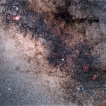Report
Stargazing with binoculars is a speedy way to see celestial objects in awesome detail. project nightflight has developed an astrophotography and image processing technique to show some deep-sky objects as they appear in binoculars. This way we would like to encourage stargazers to use their binoculars for finding their way around in the nightsky.
For the simulation images we use HDR imaging technology and a special filter to make the final image look almost exactly as seen through a binocular. The field of view of our binocular simulations spans six degrees, which represents the typical 8x30 or 10x50 binos used for stargazing. We combine two series of images of the same object shot with different exposure times to get a dynamic range similar to that of the human eye. This gives our bino sims the necessary brilliance and the sky background its profound smoothness. In addition, we use another exposure shot through a soft blurring filter to surround the stars and clusters with that hazy glow that bright objects tend to show in binoculars.
This is the second image in our series of binocular simulations, which we kicked off with the Perseus Double Cluster in 2016. The present image shows the unequal pair of star clusters, M46 and M47, in the constellation Puppis. They are located some twelve degrees to the east of Sirius, the brightest star in our nightsky. Although they fit well in a binocular field, they hardly have anything in common, except that both are open clusters. M46 shows a soft, circular glow that is generated by around 150 stars of magnitudes 10-13. M47 is more irregular with fewer but brighter individual stars. They are best observed in the late winter months, starting February, when they begin to appear in the early evening sky. A dark location without light pollution is favorable for binocular stargazing. We shot the image of M46/M47 on La Palma island from an altitude of about 1000 meters above sea level.
Cedit: www.project-nightflight.net
About Me
Contact
| Location: | Vienna, Vienna Austria  |
|---|---|
| Website: | www.project-nightflight.net |









Comments